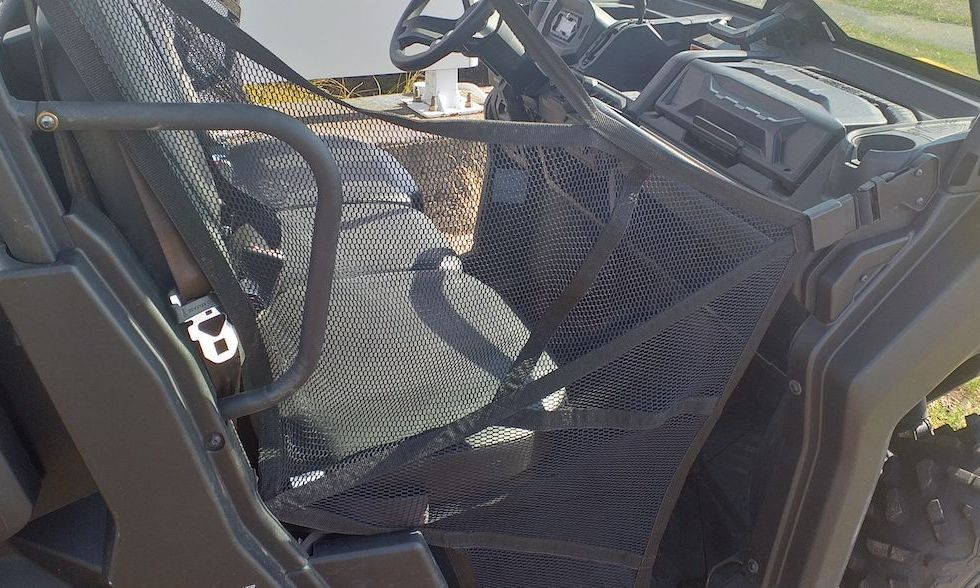Be safe with your Side x Side - it might look like a small car, but it is not!

Safe use of side-by-sides from Worksafe
Here are the main points you need to know.
A side-by-side is a small four-wheel drive vehicle designed mainly for off-road use.
A side-by-side that is fitted with seatbelts and a certified roll-over protective structure (ROPS), and used within the limits it was designed for, will offer better protection in an off-road environment than an unenclosed vehicle such as a quad or two-wheeler.
Make sure the side-by-side is:
Always drive within the limits:
Keep your arms and legs inside the side-by-side while it’s moving. Have a ‘working alone’ plan. This may include:
Wear a seat belt and a helmet – they could save your life.
Make sure a side-by-side is right for the job
The right vehicle is the safest one, even if it’s not the most convenient.
Things to consider:
Know and follow the owner’s manual
The manual has information about maintenance and operation, including features and controls, active driving techniques, load capacity, and tyre pressure. Stick to any limits recommended by the manufacturer.
Can your side-by -side be safely operated on and off the road?
The owner’s manual will tell you whether your side-by-side is designed for off-road work only or whether it can travel safely on the road. See the ATV section of the NZTA website. for information about when a side-by-side can be operated on public roads. There are certain conditions that must be met.
The tyres on some side-by-side vehicles aren’t designed for use on sealed road surfaces or paved areas. Handling and control of the vehicle can be seriously affected. Your side-by-side could roll over if you turn sharply. The large low-pressure tyres and high centre of gravity can make it unstable.
Keep your side-by-side in good condition
Your side-by-side needs regular maintenance to keep it running smoothly and safely.
Find out what needs to be maintained, and when:
What to check before you head off
Before using a side-by-side that you haven’t used in a while, or one that someone else has driven, always check that:
Make sure the ROPS is sound
Your side-by-side should have a certified ROPS (sometimes called a roll cage) installed when you buy it. Any changes to the ROPS should be certified by a Registered Engineer.
Cracks, bends, rust or other damage to the ROPS can weaken it.
A weak ROPS is far less effective if you crash. We attended a fatal accident where a rusted ROPS provided no protection for the operator when the vehicle rolled over.
Even a sound ROPS will not protect you and your passengers if you are not wearing a seat belt.
Know your side-by-side
Training improves skills, knowledge and confidence
Operating a side-by-side safely doesn’t come naturally.
A hands-on course run by a competent and experienced instructor is a good way to learn. Courses are held in most parts of New Zealand.
Refresher training can help to strengthen your skills and competence.
You and your side-by-side both need to perform
You should know how your side-by-side performs. How does it handle slopes, loads, boggy or unstable ground, and other challenging situations?
Don’t use a side-by-side if you are not familiar with it, or have not been trained to use it.
You need to be aware and alert to operate a side-by-side safely. Never operate a side-by-side if you:
Take extra care when driving up and down slopes
Ask your vehicle dealer how to safely drive up and down slopes.
Different vehicles handle slopes in different ways. You need to know the limitations of your side-by-side. Check every slope before you go up or down it. How steep is it? How rough is the terrain? How much ground cover does it have?
Tipping and roll-overs
Your side-by-side can suddenly tip or roll over in a challenging environment such as an area with steep slopes or bumpy ground. If this happens, the ROPS will only protect you if you are restrained by a seat belt. The force of an accident can be so strong that it’s almost impossible to keep yourself inside the vehicle unless you are wearing a seat belt. Your arms, legs, hands, feet or head could be crushed between the ROPS and the ground if you are not restrained.
If you feel the vehicle might tip, brace your feet on the floor or footrests and keep your hands on the steering wheel. Passengers should hold onto the grab bar – not the ROPS.
Nets, doors and guarding
Consider fitting side doors, nets and metal skid plates if they were not already installed in the side-by-side when you bought it. They can protect people in the vehicle from falling, flying or protruding objects such as branches.
Nets and doors can stop you being flung outside the ROPS if the side-by-side rolls over. Never remove them – they could help to save your life.
Stick to the manufacturer’s load and towing limits
A side-by-side usually has a cargo bed (tray) behind the seats and above the rear axle. Many side-by-sides are also able to tow a load.
Loads – especially fluids – can change the centre of gravity and significantly alter how your side-by-side handles. If the vehicle is over-loaded, or incorrectly loaded, it’s more likely to roll over.
Only use a trailer that’s suitable for the task and suitable for a side-by-side.
Always check the owner’s manual before making modifications that could affect handling or stability, such as fitting spray tanks.
The tray/cargo bed is not safe for passengers
Never carry passengers in the tray/cargo bed. The extra weight could cause you to lose control of the side-by-side.
The tray/cargo bed will not protect passengers if you crash. They could suffer a serious injury or die.
Protect your brain
You’ve only got one brain. Look after it. Wear a helmet whether you are travelling on or off the road.
Your helmet should:
In a crash your brain could be damaged if your head slams into the exposed steel frame, knocks against a passenger’s head, or hits the ground.
The Health and Safety at Work Act 2015 (HSWA) requires work-related health and safety risks to be managed. Wearing a helmet when you’re riding in a side-by-side is a proven way to manage the risk of head injury.
If you’re using your side-by-side for work:
A seat belt can save your life
If your side-by-side has a seat belt fitted, wear it. Check often that seatbelts and anchor points are in good condition.
When someone dies at work in a vehicle accident – especially on a farm – we often find that they weren’t wearing a seat belt.
Don’t rely on the ROPS to keep you safe from harm. A ROPS will only protect you and your passengers if you are also restrained by a seat belt.
Always check the ground conditions
Snow, ice, rain, heavy winds, extreme heat and other weather events can affect ground conditions. The conditions can get worse quickly. Tracks can become slippery or bumpy. A storm could bring down trees that block your route. Make sure everyone knows what areas are off-limits.
If you can’t see what the ground conditions are like then get off the side-by-side and walk the area before you drive on it.
Look out for holes, rocks or other obstacles, grooves and uneven ground. Vegetation (plants etc) can cover up unsafe surfaces that could make your side-by-side unstable.
Pay attention
Many accidents happen because the operator is distracted or trying to do several things at once. Focus on where you’re going. Stop if you need to have a good look at something, such as stock or a broken fence.
Children and young people
Never let anyone aged under 16 operate a side-by-side. Most children and young people will not have the skills, abilities or judgement to operate a side-by-side safely. They:
A child or young person should only be a passenger in a side-by-side if they are tall enough to sit comfortably with their feet on the floor and they can reach and hold on to the grab bar.
Choosing the right vehicle for the job
1 - On flat ground, provided the spray unit is purpose built for use on a quad bike, and with baffles in tank. Do not exceed quad bike manufacturer’s carrier limits, including unit total weight and fluid.
2 - Appropriate to carry up to two dogs only.
3 - Only use trailers suitable for use with the vehicle. Do not exceed vehicle manufacturer’s towing limits.
4 - Operate vehicle in four-wheel drive mode.


